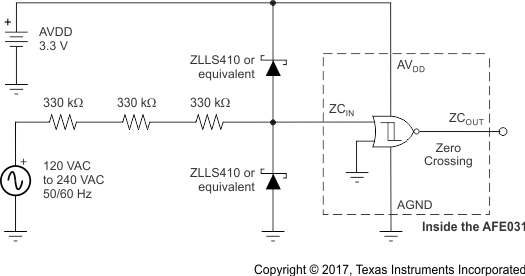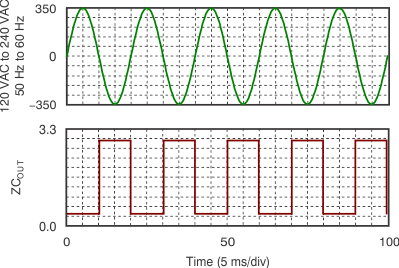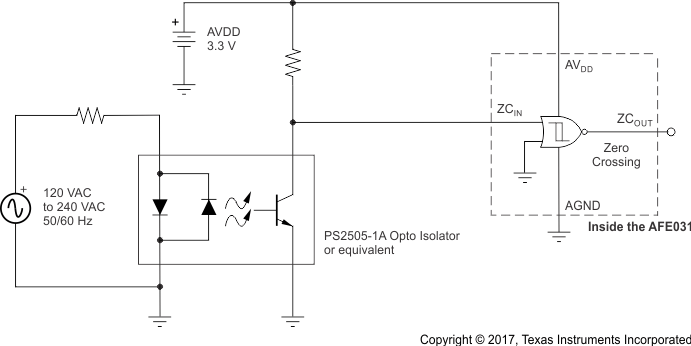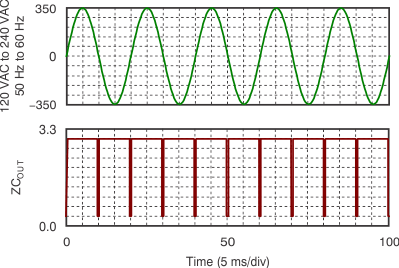ZHCS339E August 2010 – June 2019 AFE031
PRODUCTION DATA.
- 1 特性
- 2 应用
- 3 说明
- 4 修订历史记录
- 5 说明(续)
- 6 Device Comparison Table
- 7 Pin Configuration and Functions
-
8 Specifications
- 8.1 Absolute Maximum Ratings
- 8.2 ESD Ratings
- 8.3 Thermal Information
- 8.4 Electrical Characteristics: Transmitter (Tx)
- 8.5 Electrical Characteristics: Power Amplifier (PA)
- 8.6 Electrical Characteristics: Receiver (Rx)
- 8.7 Electrical Characteristics: Digital
- 8.8 Electrical Characteristics: Two-Wire Interface
- 8.9 Electrical Characteristics: Internal Bias Generator
- 8.10 Electrical Characteristics: Power Supply
- 8.11 Timing Requirements
- 8.12 Timing Diagrams
- 8.13 Typical Characteristics
- 9 Detailed Description
- 10Application and Implementation
- 11器件和文档支持
- 12机械、封装和可订购信息
9.2.6 Zero Crossing Detector Block
The AFE031 includes two zero crossing detectors. Zero crossing detectors can be used to synchronize communications signals to the ac line or sources of noise. Typically, in single-phase applications, only a single zero crossing detector is used. In three-phase applications, both zero crossing detectors can be used; one component detects phase A, and one detects phase B. Phase C zero crossings can then be inferred from the data gathered from the other phases. Figure 37 shows the AFE031 configured for non-isolated zero crossing detection.
 Figure 37. Non-Isolated Zero Crossing Detection Using the AFE031
Figure 37. Non-Isolated Zero Crossing Detection Using the AFE031 Non-isolated zero crossing waveforms are shown in Figure 38.
 Figure 38. Non-Isolated Zero Crossing Waveforms
Figure 38. Non-Isolated Zero Crossing Waveforms For maximum protection of the AFE031 against line transients, it is recommended to use Schottky diodes as indicated in Figure 37. These diodes should limit the ZC_IN pins (pins 38 and 39) to within the maximum rating of (AVDD + 0.4 V) and (AGND – 0.4 V). Some applications may require an isolated zero crossing detection circuit. With a minimal amount of components, the AFE031 can be configured for isolated zero crossing detection, as Figure 39 shows.
 Figure 39. Isolated Zero Crossing Detection Using the AFE031
Figure 39. Isolated Zero Crossing Detection Using the AFE031 Isolated zero crossing waveforms are shown in Figure 40.
 Figure 40. Isolated Zero Crossing Waveforms
Figure 40. Isolated Zero Crossing Waveforms